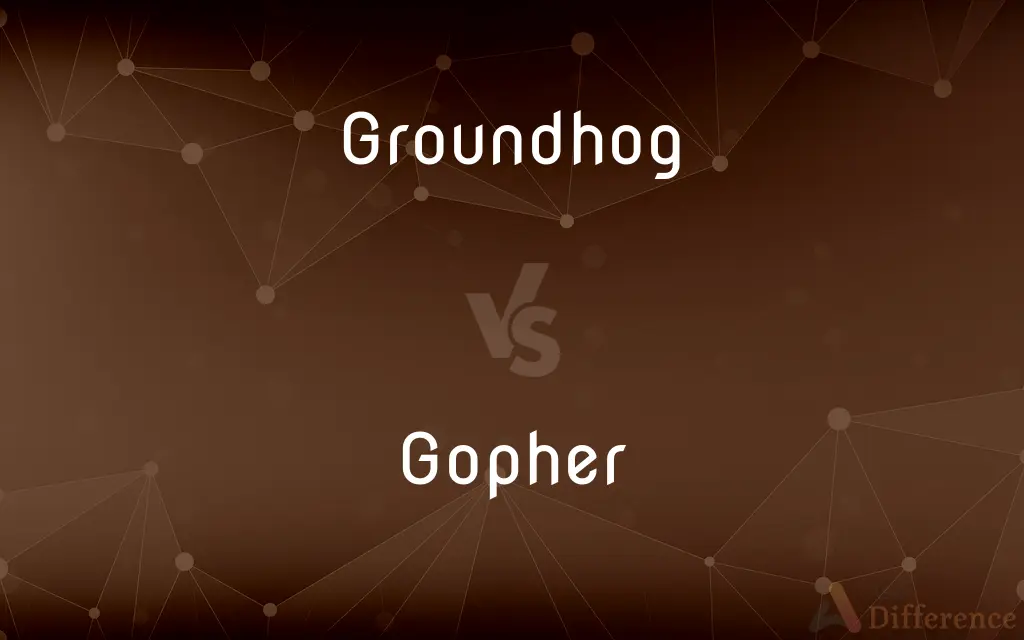Groundhog vs. Gopher — What's the Difference?
Edited by Tayyaba Rehman — By Fiza Rafique — Updated on September 25, 2023
Groundhogs are larger, North American rodents known for burrowing and for their role in folklore about predicting spring. Gophers are smaller, burrowing rodents found mainly in the western U.S. and are not involved in folklore.

Difference Between Groundhog and Gopher
Table of Contents
ADVERTISEMENT
Key Differences
Groundhogs and Gophers are both rodents that live in burrows, but they belong to different families. Groundhogs, also known as woodchucks, belong to the Sciuridae family and are native to North America. They are mostly known for their role in American folklore about predicting the arrival of spring.
Gophers, on the other hand, belong to the family Geomyidae and are smaller in size compared to groundhogs. They are mainly found in the western United States and do not have a significant role in American folklore. They are often regarded as agricultural pests due to their habit of digging extensive tunnel systems that can disrupt farming.
Both groundhogs and gophers are burrowing animals, but their burrows are structurally different. Groundhogs dig deeper burrows and often have a series of tunnels. Gophers tend to dig shallower tunnels and often construct crescent-shaped mounds at the surface.
Physically, groundhogs are larger and have a stout body, while gophers are smaller and have a more slender form. Groundhogs are also more likely to be seen above ground, often standing on their hind legs to look around, whereas gophers are more reclusive and spend much of their time underground.
Comparison Chart
Family
Sciuridae
Geomyidae
ADVERTISEMENT
Geographical Distribution
Mainly North America
Mainly western U.S.
Size
Larger
Smaller
Role in Folklore
Involved (Spring prediction)
Not involved
Burrow Complexity
More complex and deeper
Shallower
Compare with Definitions
Groundhog
A member of the Sciuridae family.
The groundhog is related to squirrels.
Gopher
An animal often considered an agricultural pest.
The gopher tunnels have disrupted the irrigation.
Groundhog
A North American rodent known for its burrowing habits.
The groundhog has dug a new burrow in the yard.
Gopher
A member of the Geomyidae family.
Gophers are not closely related to groundhogs.
Groundhog
An animal used in American folklore to predict spring.
According to the groundhog, spring will come early this year.
Gopher
A small burrowing rodent primarily found in the western U.S.
The gopher has been digging up the garden.
Groundhog
A diurnal creature active during the daytime.
The groundhog was foraging for food in broad daylight.
Gopher
A creature that constructs crescent-shaped mounds.
You can tell a gopher's presence by the mounds in the yard.
Groundhog
A larger-sized rodent often found in meadows and fields.
I saw a groundhog near the old barn.
Gopher
A rodent with a slender body.
The gopher easily slipped through the fence.
Groundhog
The groundhog (Marmota monax), also known as a woodchuck, is a rodent of the family Sciuridae, belonging to the group of large ground squirrels known as marmots. The groundhog is a lowland creature of North America; it is found through much of the eastern United States, across Canada and into Alaska.
Gopher
Pocket gophers, commonly referred to simply as gophers, are burrowing rodents of the family Geomyidae. The roughly 35 species are all endemic to North and Central America.
Groundhog
Another term for woodchuck
Gopher
Any of various short-tailed, burrowing rodents of the family Geomyidae of North America, having fur-lined external cheek pouches. Also called pocket gopher.
Groundhog
See woodchuck.
Gopher
Any of various ground squirrels of North American prairies.
Groundhog
A red-brown marmot, Marmota monax, native to North America.
Gopher
See gopher tortoise.
Groundhog
(rare) The aardvark.
Gopher
A small burrowing rodent native to North and Central America, especially in the family Geomyidae (true gophers).
Pocket gopher
Groundhog
A reddish brown North American burrowing marmot (Marmota monax), also called the woodchuck. It hibernates in the winter.
Gopher
The ground squirrel.
Groundhog
Reddish brown North American marmot
Gopher
The gopher tortoise.
Gopher
The gopher rockfish.
Gopher
One of several North American burrowing rodents of the genera Geomys and Thomomys, of the family Geomyidæ; - called also pocket gopher and pouched rat. See Pocket gopher, and Tucan.
Gopher
One of several western American species of the genus Spermophilus, of the family Sciuridæ; as, the gray gopher (Spermophilus Franklini) and the striped gopher (S. tridecemlineatus); - called also striped prairie squirrel, leopard marmot, and leopard spermophile. See Spermophile.
Gopher
A large land tortoise (Testudo Carilina) of the Southern United States, which makes extensive burrows.
Gopher
A large burrowing snake (Spilotes Couperi) of the Southern United States.
Gopher
A zealously energetic person (especially a salesman)
Gopher
Any of various terrestrial burrowing rodents of Old and New Worlds; often destroy crops
Gopher
Burrowing rodent of the family Geomyidae having large external cheek pouches; of Central America and southwestern North America
Gopher
Burrowing edible land tortoise of southeastern North America
Common Curiosities
Are groundhogs and gophers the same?
No, they are different animals from different families.
Where are groundhogs commonly found?
They are primarily found in North America.
What family does the gopher belong to?
The gopher belongs to the Geomyidae family.
Do gophers have any folklore associated with them?
No, gophers are not generally involved in folklore.
What family does the groundhog belong to?
The groundhog belongs to the Sciuridae family.
What do gophers eat?
They primarily eat roots and tubers.
Where are gophers commonly found?
They are mainly found in the western United States.
Do groundhogs have folklore associated with them?
Yes, groundhogs are famous for predicting the arrival of spring in American folklore.
Are both groundhogs and gophers considered pests?
Groundhogs can be, but gophers are more often seen as agricultural pests.
What do groundhogs eat?
They are mostly herbivores, eating a variety of plants and occasionally small insects.
Do groundhogs dig deeper burrows than gophers?
Yes, groundhog burrows are generally deeper and more complex.
Are gophers diurnal?
Gophers can be active at any time but are often less visible due to their reclusive nature.
Are groundhogs larger than gophers?
Yes, groundhogs are generally larger.
Can groundhogs climb trees?
Yes, although it's rare, they can climb trees.
Are groundhogs diurnal?
Yes, groundhogs are mainly active during the daytime.
Share Your Discovery

Previous Comparison
Hoop vs. Loop
Next Comparison
Base vs. BasisAuthor Spotlight
Written by
Fiza RafiqueFiza Rafique is a skilled content writer at AskDifference.com, where she meticulously refines and enhances written pieces. Drawing from her vast editorial expertise, Fiza ensures clarity, accuracy, and precision in every article. Passionate about language, she continually seeks to elevate the quality of content for readers worldwide.
Edited by
Tayyaba RehmanTayyaba Rehman is a distinguished writer, currently serving as a primary contributor to askdifference.com. As a researcher in semantics and etymology, Tayyaba's passion for the complexity of languages and their distinctions has found a perfect home on the platform. Tayyaba delves into the intricacies of language, distinguishing between commonly confused words and phrases, thereby providing clarity for readers worldwide.
















































